Aloidendron
Aloidendron (A.Berger) Klopper & Gideon F.Sm.
Family: Asphodelaceae
Common names: tree aloes (Eng.); boomaalwyne (Afr.)
Introduction
Tree aloes, with their striking, bold and often symmetrical architecture and drought tolerance, are sought after by gardeners and make perfect focus plants in larger gardens.

Description
Description
Tree aloes form large trees and shrubs, with forked (dichotomous) branches. Most have a tall trunk and rounded crown. Some of the largest species can grow up to 20 m tall. Their grey to yellowish bark is smooth or longitudinally fissured and cracked, and often with a powdery bloom.
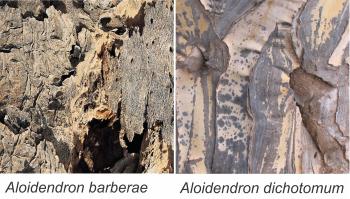
The succulent, erectly spreading to recurved leaves are carried in clusters (rosettes) at the tips of branches, and are narrowly lance- or sword-shaped in outline and boat-shaped in cross-section. Leaf margins are armed with small teeth and the leaf surface is green to grey-green with no spots.
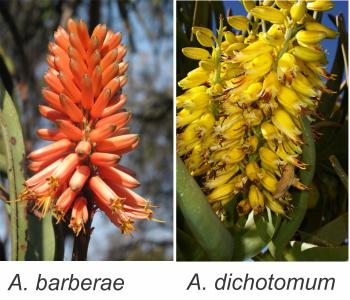
Flowers are grouped in branched inflorescences with rather lax or dense, cylindric racemes (flower clusters). In the species occurring in the west of the genus’s distribution range, flowers are yellow, whereas they are pink or orange to reddish in the eastern species. Flowers are cylindric and slightly swollen in the middle. The fruit are capsules that dry out and split open to release the mature seed. Tree aloes all flower in late autumn to winter, except for Aloidendron pillansii that flowers in spring (October in the southern hemisphere).
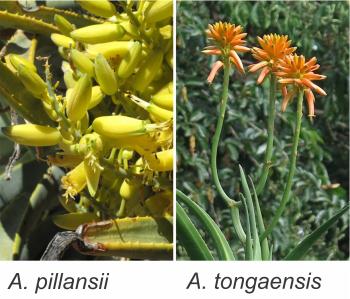
Apart from the slow-growing A. pillansii and A. tongaensis, most other tree aloes are relatively fast growing. They are all long-lived plants. A specific quiver tree (A. dichotomum) was estimated to be between 100–145 years old.
Conservation Status
Status
All species of Aloidendron appear on CITES (Convention on the International Trade in Endangered Species of Wild Fauna and Flora) Appendices, meaning that trade in tree aloes is controlled, to prevent utilisation that would be incompatible with their survival. Aloidendron pillansii is included in Appendix I, and trade in specimens of this tree aloe is permitted only in exceptional circumstances. The other tree aloes are all on Appendix II and, therefore, certain permits are required to trade in them.
In South Africa tree aloes are also protected by national and provincial environmental legislation. It is thus illegal to remove plants from their natural habitat without the necessary collecting and transport permits issued by a provincial or other nature conservation authority, and consent from the land owner.
In the Red List of South African plants, A. barberae and A. tongaensis are listed as Least Concern (LC), A. dichotomum and A. ramosissimum as Vulnerable (V) and A. pillansii as Endangered (E). Aloidendron eminens (from Somalia) is listed as Endangered on the IUCN Red List of Threatened Species. Common threats to the survival of tree aloes are habitat degradation and destruction, trampling of seedlings by livestock, illegal harvesting and climate change.
Distribution and habitat
Distribution description
The genus Aloidendron consists of six or seven species. The placement of Aloe sabaea in this genus is controversial and is not supported by all aloe enthusiasts. Southern Africa is a centre of diversity for tree aloes, as five of the species are endemic or near-endemic to this region. The two species not present in southern Africa are: Aloidendron eminens that is only found in Somalia, and Aloidendron sabaeum that only occurs in Saudi Arabia and Yemen.
Aloidendron barberae and A. tongaensis are confined to the summer-rainfall area and grow in the coastal forests of eastern and northeastern southern Africa. Aloidendron ramosissimum and A. pillansii is restricted to the Richtersveld in the winter-rainfall region of far northwestern South Africa and southeastern Namibia. Aloidendron dichotomum is one of the more widespread tree aloes and occurs in the predominantly winter-rainfall regions of the Northern Cape (South Africa) and Namibia.
Derivation of name and historical aspects
History
The genus name is derived from combining the words ‘aloe’ and ‘dendron’ (= tree). It literally means ‘tree aloe’
Ecology
Ecology
Capsules generally ripen in winter or spring and seed is then dispersed, often with the rains for species in the summer-rainfall region. Pollinators include sunbirds, short-beaked weavers, starlings and white-eyes. Being succulent, tree aloes are very drought tolerant.

Uses
Use
Tree aloes are widely used in horticulture and landscaping, as they make good focal plants in large gardens. Their succulent nature also led them to be used as fire barriers around homesteads in fire-prone areas. The light, fibrous wood of Aloidendron dichotomum has been used in the construction of cool rooms or small houses in Namaqualand. Hollowed-out branches of this species was also traditionally used by the Khoi-San to make quivers for their arrows, hence the common name of quiver tree. Aloidendron pillansii seems to be an indicator of heavy metal soils in Namibia. The winter-rainfall species, especially Aloidendron dichotomum, are often seen as flagship species for climate change impacts on biodiversity. In northern KwaZulu-Natal, South Africa, tree aloes are normally not cut down with the rest of the forest, as they are believed to protect against evil spirits and to serve as lightning conductors.
Growing Aloidendron
Grow
The fact that tree aloes adapt well to cultivation and are thus generally easily grown, has led to them being widely utilised as focal points in large gardens. However, the 3 tree aloes from the arid western regions, although easily grown in conditions simulating their natural habitat, are difficult to cultivate in high rainfall areas. All tree aloes prefer a well-drained position with no to very little frost. Aloidendron dichotomum, A. pillansii and A. ramosissimum prefer full sun, whereas A. barberae and A. tongaensis can tolerate more shady conditions.
Most tree aloes (except A. dichotomum and A. pillansii, and to some extent A. ramosissimum) can be grown from stem cuttings or truncheons. Cuttings should be made during the warmer months, using a sharp pruning shear or saw and the wound treated to prevent infection. Cuttings can be planted directly into the required position and normally root within 1 to 3 months.
All tree aloes can fairly easily be grown from seed and are relatively fast growing (except A. tongaensis and A. pillansii). Seed are best sown in spring to autumn and will generally germinate within three weeks. When seedlings are large enough (normally within a year) they can be planted out and hardened off.
Species
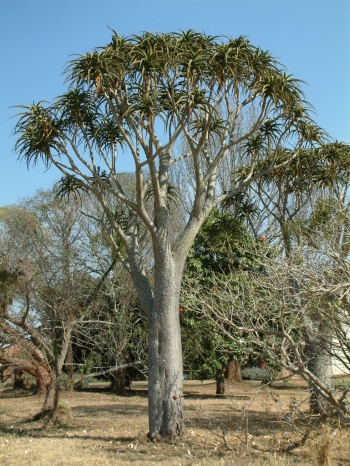
Aloidendron barberae (Dyer) Klopper & Gideon F.Sm.
The eastern tree aloe is the tallest and largest of the South African tree aloes, forming tall, much-branched trees of up to 18 m. The bark is greyish and rough to the touch. Dense inflorescences with rose-pink flowers, which are pollinated by short-beaked weavers and white-eyes, are often hidden among the bright green leaves. It grows in dense, tall bush and low forest, on rocky slopes of wooded valleys. The eastern tree aloe occurs in scattered localities in a broad coastal zone from East London in the Eastern Cape, through KwaZulu-Natal, and Mpumalanga, South Africa, also in Swaziland and along the southern Mozambique coast, as far north as Inhambane, with a known disjunct collection further north in the Cheringoma District of eastcentral Mozambique.
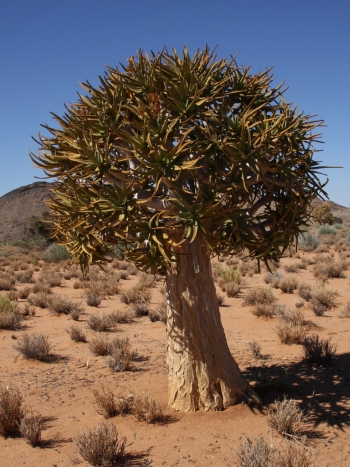
Aloidendron dichotomum (Masson) Klopper & Gideon F.Sm.
The distinctive quiver tree is a much-branched tree aloe, with a thick trunk, peeling bark and a rounded crown. Flowers are bright yellow, borne in short, erect, few-branched inflorescences and pollinated by weavers, starlings, white-eyes and sunbirds. It grows in arid, rocky hillsides in the western and northwestern regions receiving minimal rainfall. The quiver tree occurs from the Brandberg in Namibia southwards to Nieuwoudtville, and eastwards to Upington and Kenhardt in South Africa.
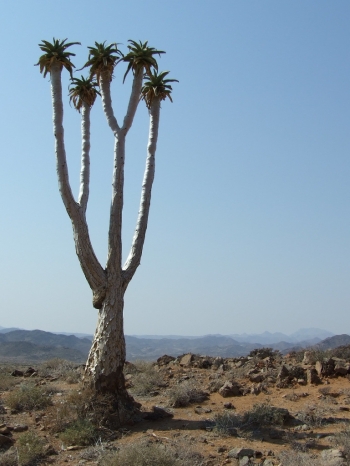
Aloidendron pillansii (L.Guthrie) Klopper & Gideon F.Sm.
The giant quiver tree has a very distinctive growth form, with a huge trunk and a few, large rosettes on the smooth, forked branches. The broad leaves are sliver-grey with white margins and teeth. Inflorescences with yellow, slightly swollen flowers are produced laterally from axils of the lowest leaves. The giant quiver tree grows on stony hillsides that are almost devoid of soil in Succulent Karoo vegetation, at low altitudes. It is only known from the Richtersveld, South Africa, and adjacent areas of Namibia.
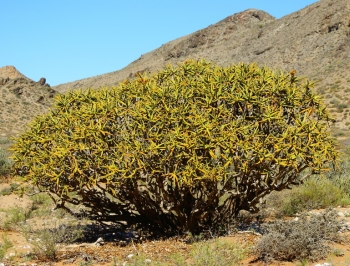
Aloidendron ramosissimum (Pillans) Klopper & Gideon F.Sm.
The maiden’s quiver tree is a shrub that branches profusely from ground level, with slender branches and small rosettes and leaves. The yellow, swollen flowers are borne in erect, rather dense inflorescences. It grows in arid hot country, on hills and mountain slopes. The maiden’s quiver tree occurs from the Aurusberge in Namibia to the Richtersveld of the Northern Cape, South Africa.
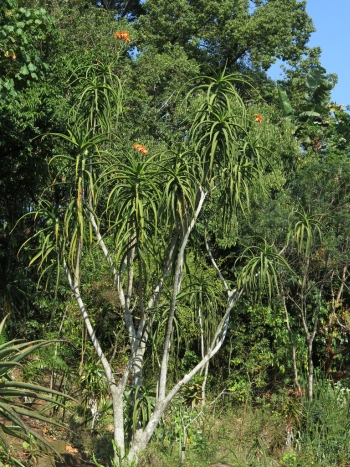
Aloidendron tongaensis (Van Jaarsv.) Klopper & Gideon F.Sm.
The Tonga tree aloe forms branched trees of up to 8 m, with terminal rosettes of recurved, dull green leaves. The curved, yellowish orange flowers are drooping (pendulous), borne in short, dense, erect, few-branched inflorescences and are pollinated by sunbirds. It only grows in sand forest, in warm, humid, tropical/subtropical conditions, on sandy soil. The Tonga tree aloe is restricted to the sand forests at Kosi Bay in northern KwaZulu-Natal, South Africa and adjacent territory of southern Mozambique.
References
- Red List of South African plants. 2016. Genus Aloidendron. http://redlist.sanbi.org/genus.php?genus=15461. Accessed on 22 June 2016.
- Reynolds, G.W. 1950. The aloes of South Africa. Trustees of the Aloes of South Africa Book Fund, Johannesburg.
- Van Jaarsveld, E.J. & Judd, E. 2015. Tree aloes of Africa. Penrock Publications, Cape Town.
- Von Staden, L., Nichols, G. & Grieve, G. 2013. Aloidendron tongaense (Van Jaarsv.) Klopper & Gideon F.Sm. National Assessment: Red List of South African plants version 2015.1. Accessed on 22 June 2016.
- Weber, O. 2013. Aloe eminens. The IUCN Red List of Threatened Species 2013: e.T30747A2795911. http://dx.doi.org/10.2305/IUCN.UK.2013-2.RLTS.T30747A2795911.en. Accessed on 22 June 2016.
Credits
Ronell R. Klopper
National Herbarium, Pretoria
August 2016
The author thanks Neil R. Crouch, Gideon F. Smith, Hester M. Steyn and Arrie W. Klopper for supplying the images, as follows:
Neil R. Crouch: A. barberae plant, A.barberae flowers, A. dichotomum bark, A. dichotomum capsules, A. pillansi capsules, A. pillansii flowers, A. tongaensis plant, A. tongaensis flowers, A. dichotomum forest.
Gideon F. Smith: A. barberae bark
Hester M. Steyn: A. dichotomum plant, A. pillansii plant
Arrie W. Klopper: A. dichotomum flowers, A. ramosissimum plant
Plant Attributes:
Plant Type:
SA Distribution:
Soil type:
Flowering season:
PH:
Flower colour:
Aspect:
Gardening skill:
Special Features:
Horticultural zones






Rate this article
Article well written and informative
Rate this plant
Is this an interesting plant?
Login to add your Comment
Back to topNot registered yet? Click here to register.